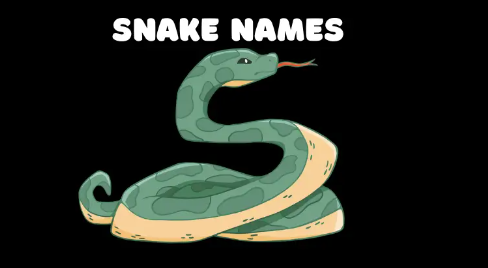Snakes, often associated with danger, mystery, and the unknown, have captured human imagination for centuries. Their serpentine forms, often slithering through dark and hidden places, have led to their association with the supernatural and the demonic. This exploration delves into the world of demon snake names, exploring the origins, meanings, and cultural significance behind these fearsome appellations.

Demon Snake Names: A Historical Overview
The concept of demon snakes has roots in ancient mythologies and folklore. In many cultures, snakes were seen as symbols of evil, temptation, and destruction. They were often associated with deities or demons who embodied these negative qualities.
- Ancient Egyptian Mythology: Snakes were closely linked to the goddess Sekhmet, a fierce and powerful deity associated with war, disease, and destruction. The cobra, in particular, was seen as a symbol of royal power and protection, but it could also be a harbinger of doom.
- Greek Mythology: The Hydra, a multi-headed serpent, was a fearsome creature associated with the underworld and the god Hades. It was often depicted as a symbol of chaos and evil.
- Norse Mythology: The Midgard Serpent, a colossal sea serpent, was believed to encircle the world. Its death was a sign of the impending Ragnarök, the final battle that would destroy the world.
Demon Names for Snakes: A Thematic Exploration
Demon snake names often reflect their perceived characteristics, such as their appearance, behavior, or association with evil forces. Here are some common themes:
- Appearance: Names that describe the snake’s physical attributes, such as its color, size, or markings. Examples include “Black Adder,” “Red-Eyed Viper,” and “Scaled Horror.”
- Behavior: Names that allude to the snake’s predatory nature, its ability to strike quickly, or its stealthy movements. Examples include “Deathstrike,” “Shadowstalker,” and “Venomfang.”
- Association with Evil: Names that directly connect the snake to demonic or evil forces. Examples include “Hellfire Serpent,” “Devil’s Kiss,” and “Abyssal Crawler.”
Demonic Snake Names: A Cultural Perspective
Demon snake names can vary significantly across different cultures. Some cultures may view snakes with reverence or respect, while others may associate them with fear and loathing.
- Indigenous American Cultures: Many indigenous American cultures have a deep respect for snakes and see them as symbols of wisdom and power. However, some tribes also associate snakes with the underworld and evil spirits.
- African Folklore: Snakes are often seen as powerful beings in African folklore, with some tribes believing that certain snakes possess supernatural powers. However, some snakes are also associated with witchcraft and evil.
- Eastern Cultures: In many Eastern cultures, snakes are seen as symbols of rebirth and transformation. However, some snakes are also associated with negative energy and misfortune.
Male Evil Snake Names
Male demon snake names often emphasize strength, aggression, and predatory instincts. Here are some examples:
- Venomous: Viper, Rattler, Cobra, Asp
- Predatory: Hunter, Stalker, Slayer, Destroyer
- Demonic: Infernal, Abyssal, Diabolic, Satanic
- Mythological: Hydra, Leviathan, Basilisk, Cerberus
Female Evil Snake Names
Female demon snake names may emphasize cunning, deception, and temptation. Here are some examples:
- Cunning: Siren, Temptress, Seductress, Enchantress
- Deceptive: Trickster, Illusionist, Deceiver, Misleader
- Demonic: Succubus, Incubus, Demoness, Hag
- Mythological: Lamia, Medusa, Lilith, Kali
Demon Snake Names
| Category | Male Names | Female Names |
|---|---|---|
| Venomous | Viper, Rattler, Cobra, Asp | Viperess, Rattleress, Cobress, Aspess |
| Predatory | Hunter, Stalker, Slayer, Destroyer | Huntress, Stalkress, Slayress, Destroyress |
| Demonic | Infernal, Abyssal, Diabolic, Satanic | Infernal, Abyssal, Diabolic, Satanic |
| Mythological | Hydra, Leviathan, Basilisk, Cerberus | Hydra, Leviathan, Basilisk, Cerberus |
Conclusion
Demon snake names offer a glimpse into the rich and complex world of mythology, folklore, and cultural beliefs. These fearsome appellations reflect the human fascination with the dark side of nature and the power of the supernatural. Whether they are inspired by ancient legends or modern imagination, demon snake names continue to evoke a sense of awe, fear, and mystery.
FAQs
- What is the origin of the term “demon snake”?
- The term “demon snake” is derived from the association of snakes with evil forces in various cultures.
- What are some common themes in demon snake names?
- Common themes include appearance, behavior, and association with evil forces.
- How do demon snake names vary across different cultures?
- Demon snake names can vary significantly across different cultures, reflecting their unique beliefs and traditions.
- What are some examples of male and female demon snake names?
- Examples of male demon snake names include Viper, Hunter, Infernal, and Hydra. Examples of female demon snake names include Temptress, Deceiver, Succubus, and Medusa.
- Why are demon snake names still relevant today?
- Demon snake names continue to be relevant today due to their enduring fascination and their ability to evoke a sense of fear and mystery.